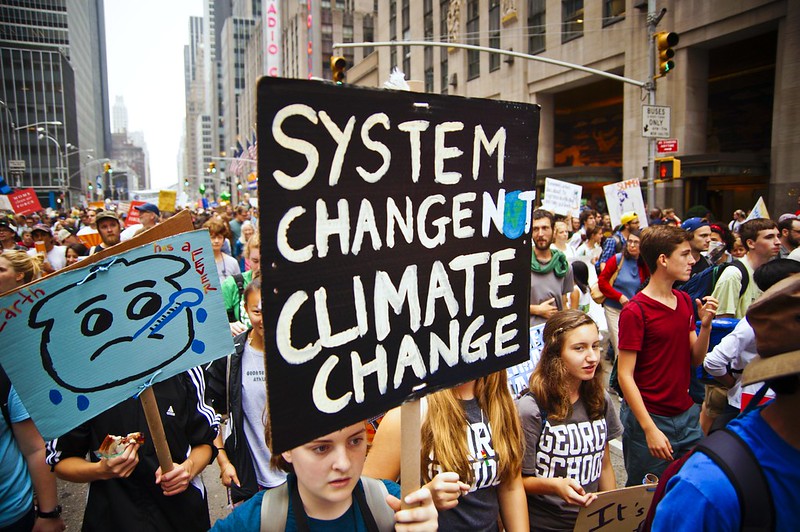Karl Marx once remarked that history repeats itself “the first time as tragedy, the second time as farce.” For the first two weeks of November, history repeated itself for the 26th time, as the world’s so-called leaders met in Glasgow and decided to do more-or-less nothing to deal with the climate crisis.
The situation facing humanity is one of very real peril. There is a desperate need to keep the increase in average world temperature below 1.5C above pre-industrial levels. As the Intergovernmental Panel on Climate Change (IPCC) has pointed out, if this temperature is exceeded, there is a very real risk that tipping points could be reached, putting humanity face to face with a potential cataclysm.
Climate change is already provoking conflict over natural resources and has caused tens of millions of people to be displaced, but beyond this threshold, these horrors could become indescribably worse, threatening humanity with a descent into barbarism. We have already reached around 1.1C of warming. To avoid an utter catastrophe, the IPCC warns that a 45 percent reduction in greenhouse gas emissions is needed by the year 2030.
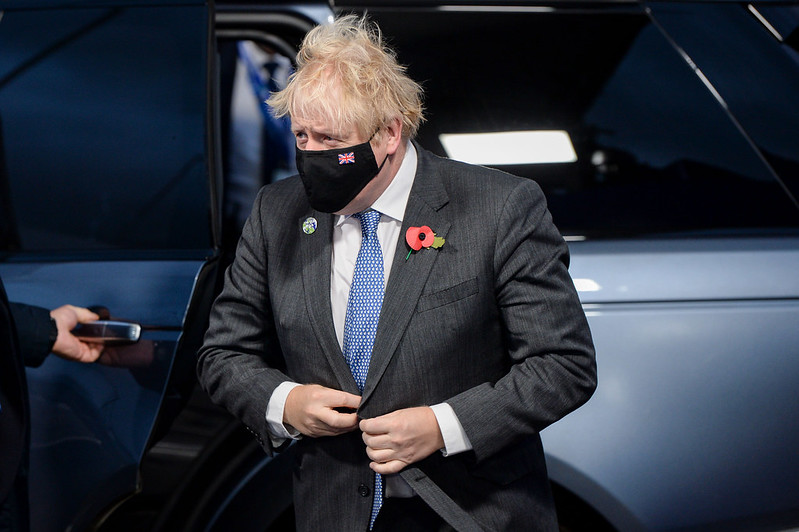 Boris Johnson has been described as “the perfect host for COP26” due to his specialism in “groundless optimism and empty pledges” / Image: COP26, Flickr
Boris Johnson has been described as “the perfect host for COP26” due to his specialism in “groundless optimism and empty pledges” / Image: COP26, Flickr
It is in this context that the latest United Nations Climate Conference, known as COP26, began. It began with a lot of fanfare. British Prime Minister Boris Johnson (aptly described by Gideon Rachman in the Financial Times as “the perfect host for COP26” due to his specialism in “groundless optimism and empty pledges”) said it would be the “turning point for humanity”.
This particular COP was described as ‘special’, because all nations were expected to come with concrete plans as to how they were going to achieve the targets set at COP21 in Paris.
The aim, according to the British hosts, was “keeping 1.5C alive”. In order to achieve this, four main priorities were drawn up: “cars, coal, cash, trees”. On each one of these, COP26 was an abject failure. The agreements that have been made are either fine words with no concrete plans as to how these will be achieved, old announcements remade, or measures that will make very little difference.
Coal
With Alok Sharma, British Tory minister and President for COP26, declaring that he wanted to “consign coal to history”, hopes were high that something could be done to phase out the dirtiest of all fossil fuels. All these fine words, however, are worth nothing. Over the course of the Conference, you saw all manner of twisting and turning. The reason for this is the division of the world into competing nation states, a fundamental characteristic of the capitalist system. Each government is happy to call for action, but will never allow anything to be carried out that threatens the interests of their own ruling class. That is why calls to action were invariably calls for other countries to step up or for a tightening of measures unrelated to the domestic economies of the country in question.
In the run-up to COP, 40 countries agreed to phase out the use of coal domestically and internationally. However, to convince these countries to sign up, the pledge had to be watered down substantially. Beginning with the aim of achieving this by 2030 (a target necessary to stick to 1.5C), they ended up agreeing coal would be phased out “in the 2030s for major economies and in the 2040s for the rest of the world.” This means advanced capitalist countries like Germany do not intend to end the use of coal until 2038 and other big users, such as Poland, described themselves as “developing countries” and so will not phase out the fuel until 2049.
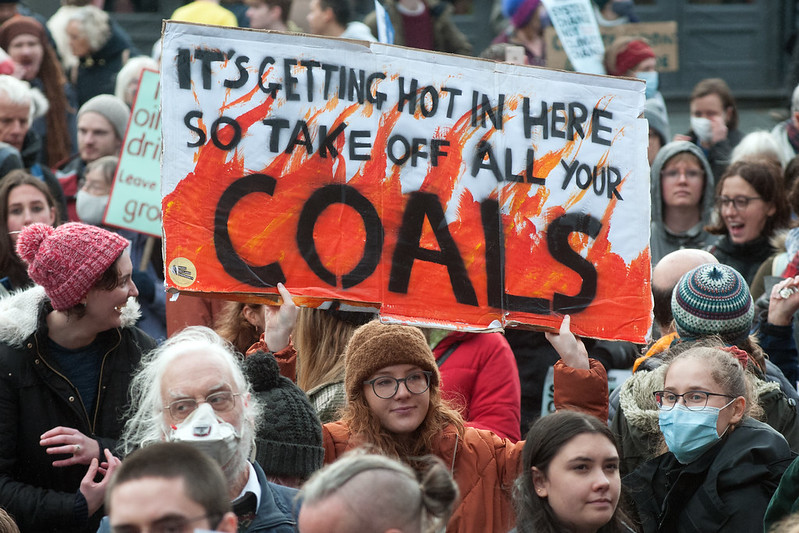 Countries like Germany do not intend to end the use of coal until 2038 and other big users, such as Poland will not phase it out until 2049 / Image: Tim Dennell, Flickr
Countries like Germany do not intend to end the use of coal until 2038 and other big users, such as Poland will not phase it out until 2049 / Image: Tim Dennell, Flickr
Additionally, the agreement doesn’t seem to be worth the paper it is written on. As the Guardian pointed out, it replicates a previous agreement that has so many loopholes that countries such as Canada can continue to develop mines merely because they export the coal elsewhere.
During COP26, delegates were tasked with making a final agreement, which would need unanimity. The original draft called on all signatories to accelerate the phasing out of coal and subsidies for fossil fuels. However, in the final stages, the Indian and Chinese delegations objected. Ultimately, it was agreed to call for the “phaseout of unabated coal power and of inefficient subsidies for fossil fuels”.
Much of the criticism of these countries is hypocritical. Four days after the end of COP26, the US auctioned off the biggest ever oil and gas leases in history. It is estimated this could result in the release of 600m tons of greenhouse gas emissions into the atmosphere – a figure almost double Egypt’s total emissions from 2018!
However, despite the impending climate emergency, we see constant attempts to weaken commitments. Some still try to claim this as a victory due to the fact that fossil fuels had not been mentioned in a UN climate summit text before now. But what a damning indictment it is that for decades, knowing full well what a threat fossil fuels pose, these leaders have systematically avoided the question. Any school child who has grown up during this period will know about the harmful effects of fossil fuels. And yet it takes the leaders of the capitalist class until 2021 to even mention them by name.
We stand on the precipice of an existential crisis for human civilisation, and we have these criminals as our leaders. Leon Trotsky, in the Transitional Programme, described the capitalists at the time as tobogganing towards disaster with their eyes closed. Here, we have something far worse. The capitalists who are in charge of this system have their eyes open, and are consciously prioritising the short-term interests of big business over and above the future of the human race.
The USA
Among the countries that refused to join the 40 claiming they will phase out coal was the US. After Donald Trump’s creed of ‘America First’, the liberal press the world over was optimistic that the ‘progressive’ President, Joe Biden, would bring back multilateralism in world affairs. However, while Biden signed the US up to the Paris Climate Accord again (after Trump had pulled out), he is doing nothing to really avert the climate crisis. It is still ‘America First’, just with a more human face.
In the face of the current economic crisis, where there are massive shortages of everything, including sources of power, the US has no intention of phasing out coal. Indeed, US power plants look like they will burn 23 percent more coal this year than 2020. Additionally, as pointed out in Bloomberg, Biden’s spending plan includes tax breaks for coal-fired power stations with the proviso that they install carbon-capture technology. However, this technology only needs to reduce emissions by 75 percent and companies only need to start construction by 2032 – i.e., after the date by which coal needs to be phased out!
Another consideration was the need to “avoid upsetting senators from coal-dependent states” while Biden was negotiating the US’ infrastructure bill. One of the principal troublemakers was Joe Manchin from West Virginia. And he has a very good reason to do so! Manchin receives more money in donations from the fossil fuel industry than any other Senator. In addition to this, he is thought to own between $1 million and $5 million in shares in a coal brokerage firm that he set up in 1988.
Those who thought that the Democratic Party would govern in a progressive manner should remember that it is filled with capitalists like Manchin, and rules in the interests of the US capitalist class, which has a major stake in polluting industries.
Who will pay?
Biden says he cares about the climate and Trump says he doesn’t, and the result is more-or-less the same. Biden calls on less-advanced capitalist countries to speed up the energy transition. However, a rapid move towards decarbonisation requires an estimated $3.5 trillion per year of investment, with 70 percent of that being made in less-advanced capitalist countries. Clearly, these countries will not be able to afford this themselves. After all, the economic crisis sparked by coronavirus has pushed up the debt of these countries by a record amount up to $11.3tn.
The need to fund the transition was recognised as far back as 2009, at COP15 in Copenhagen, where it was agreed to provide $100bn in climate financing for less-advanced capitalist countries by 2020. This target was missed, with an estimated total of $80bn reached so far.
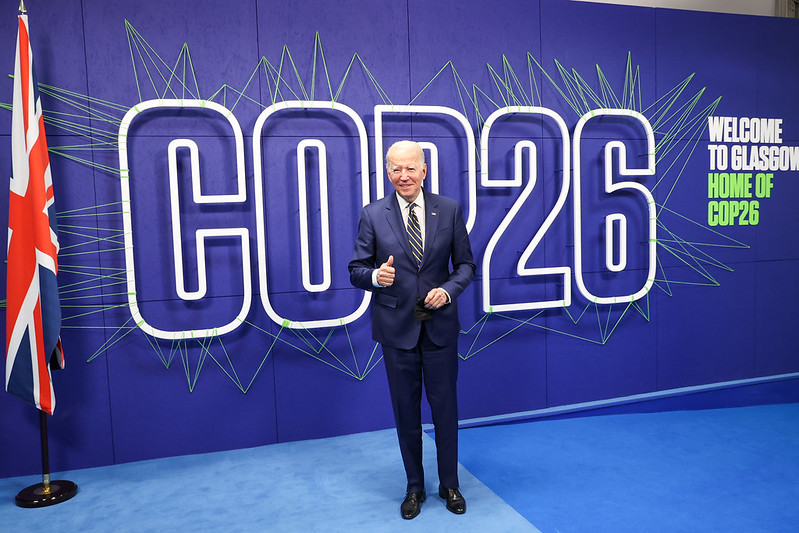 Biden says he cares about the climate and Trump says he doesn’t, and the result is more-or-less the same / Image: COP26, Flickr
Biden says he cares about the climate and Trump says he doesn’t, and the result is more-or-less the same / Image: COP26, Flickr
Whilst these figures sound like a lot, it is nothing compared to the $767bn spent by the US on its military in 2020 alone. The capitalist system has brought about a situation where just one nation spends around seven-times more on building instruments of war than on its target for averting climate change.
The latest COP agreement expressed “deep regret” at the missed target, and made a new commitment to raise at least $100bn annually up to 2025. Not only is this figure a drop in the ocean compared to what is actually needed, it is also far from altruistic. As Oxfam has pointed out, in 2018, 74 percent of public climate finance was made up of loans.
This is not unusual. Each year, around $2tn flows from the less advanced to the more advanced countries in the form of things such as loans and the repatriation of profits. This is therefore a classic imperialist relationship. Capital is offered to backward capitalist countries to build up infrastructure in exchange for large interest payments. This wealth extraction, it must also be said, matches quite closely what is said to be needed to carry out the transition. It is therefore deeply hypocritical for the leaders of the main imperialist powers to blame less advanced countries for not doing their bit.
What we see here is that economic nationalism is not just a product of Donald Trump’s brain. Under conditions of crisis, every government must all the more fiercely defend the interests of their own ruling class. In this sort of scenario, global planning to avert climate disaster is harder than ever.
The idea of providing relief for disasters was advanced by some of the poorest nations, such as Kenya and Gabon, as well as small island nations – i.e. those nations that will be hardest hit by disasters. The advanced capitalist countries, however, have no interest in saving the lives of people who live in these countries; the profits of their own ruling classes are far more important. Instead, they offered “dialogue” about funding an organisation that could provide “technical assistance”.
Deals made between smaller groups of countries
Due to the difficulties in getting countries to sign up to unanimous agreements, Alok Sharma spent the run-up to the COP scurrying around the globe trying to strike deals with smaller groups of countries.
One pledge, first announced in September, was an initiative to cut methane emissions by 30 percent by 2030. This would be very significant. Around a third of all global warming comes from methane and, whilst the gas itself dissipates into the atmosphere faster than CO2, it also warms the atmosphere much faster. Like many of these pledges, however, the most important countries have not done so. China, Russia and India, which make up the first, second and third largest emitters of methane, refused.
Similarly, the proposed deal to eliminate car emissions by 2040 was not signed by 4 of the world’s 5 largest car companies; nor by the US, China and Germany, which are 3 of the 4 countries with the largest automobile industries. Yet again, it seems that the capitalists and their governments are more than happy to save the world from catastrophic climate change… provided it does not impede their ability to make short-term profits! In a world economy divided up into competing nation states, no government is prepared to weaken its own ruling class in relation to the others.
Another pledge saw 100 world leaders agreeing to end and reverse deforestation by 2030. Deforestation itself is thought to account for 11 percent of global emissions and the countries that signed up to the pledge (including Brazil, Russia and China) contain more than 85 percent of the world’s forests.
However, this same announcement was already made in 2014 when 40 countries signed up to the New York Declaration on Forests, which committed signatories to ending deforestation by 2030 and halving it by 2020. It has been reported that, since the agreement was signed, “tropical primary forest loss has generally increased”. And in the immediate aftermath of the agreement, the Indonesian environment minister (a country with one of the largest rainforests in the world) called the deal “unfair”. For others, this deal represents a way to carry on polluting. Russia, because it contains 20 percent of the world’s forests, can claim that they have ‘offset’ their emissions. So, they can carry on polluting whilst claiming to be green.
On every question, therefore, you have capitalist governments prioritising the short-term interests of their own ruling class over and above the future survival of the human race.
Carbon markets
A big hope of the defenders of capitalism, carbon markets do already operate on a national or regional level. At COP26, a global agreement was made. In essence, carbon markets mean that, if a country or company reduces its emissions by a greater amount than stated in its goals, it can receive carbon credits equaling that value. These can then be sold to those exceeding their targets. In order to avoid pollution simply being moved from one area to another, the deal involves a 2 percent reduction in the value of the credit each time it is traded. The idea is that emissions reductions can be monetised and therefore incentivised.
However, the deal allows the use of an estimated 300m credits that were created between 2013 and 2020. Many of these credits were created in schemes that would likely still have taken place without any funding. They have therefore, in no way whatsoever, contributed to reducing the amount of carbon in the atmosphere and yet they will be used to allow polluters to pollute all the more!
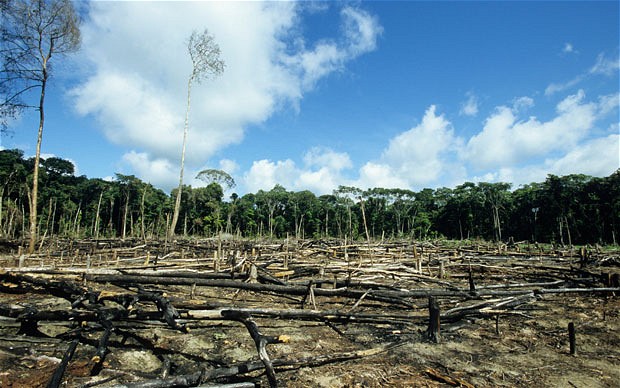 Deforestation is thought to account for 11 percent of global emissions / Image: Dikshajhingan, Wikimedia Commons
Deforestation is thought to account for 11 percent of global emissions / Image: Dikshajhingan, Wikimedia Commons
Additionally, what this means is that the market is flooded with increased supply of these credits. This then depresses prices, and therefore cuts across the supposed incentive. Carbon Market Watch also points out that the 2 percent reduction in the value of the credits is far too low to reduce emissions at the required rate.
To transition away from fossil fuels quickly enough a rapid and radical shift is required. If this was to be done using carbon markets, the price of carbon would have to be so high as to make companies and countries shift at a rapid rate. However, this will not be done for the very same reasons that countries are unwilling to sign up to promises to reduce the use of fossil fuels. This whole scheme is therefore nothing more than a greenwashing exercise, giving companies and capitalist governments cover to continue their polluting whilst claiming to be green to consumers or citizens.
Is this progress?
Before the Paris Agreement, the world was thought to be on course to reach 4 degrees of warming before the end of the century. Afterwards, the estimate was around 3 degrees. After COP26, there are different estimates. The most optimistic is 1.8 degrees, but this seems unlikely to say the least. Not only would it depend on all agreements being carried out to the letter (an unlikely prospect, as has been pointed out above), but this figure would require that all the net zero targets would have to be achieved. A whole series of nations have announced that they will reach net zero at different dates, but most of them have not set out any plans as to how they will get there. Given the record so far, this seems quite unlikely.
The promises to reach “net zero” in the dim and distant future are not enough, because there is a cumulative effect from releasing carbon dioxide. What this means is that, even if the world was to reach net zero by 2050 (the target thought necessary to keep to 1.5C), if the changes that are needed are all made right at the last minute, the cumulative effect of the greenhouse gases released into the atmosphere leading up to this point would ensure the target is missed.
In any case, despite all of the talk over the years, there has been very little change. In 1992, 78 percent of the world’s primary energy was from fossil fuels. In 2019, after 25 COPs had taken place, this proportion increased to 79 percent, and the overall amount of fossil fuel energy used had risen by 60 percent.
Some call this ‘progress’. What this means, however, is that the most optimistic (and unrealistic) assessment is that COP26 still means that the globe shoots over the 1.5C target. If this is progress, it resembles a snail fleeing an oncoming car. Rather than this dithering, we need fundamental and rapid change.
What can be done?
The Economist ran a weekly podcast to coincide with COP26, which finished last Monday. At the end of the final episode, the main host turned to his two colleagues and joked: “If I had to be trapped on the Titanic, and it certainly seems that I am, then I would rather spend it with you two discussing the arrangement of deckchairs”.
The representatives of the ruling class are in complete despair. They wonder why public opinion can’t sway governments. The Financial Times points out that, whilst a large percentage of the populations of many countries list climate change as one of the most important issues, when those like Macron attempt to deal with the problem, you get “a year of social and political turmoil.”
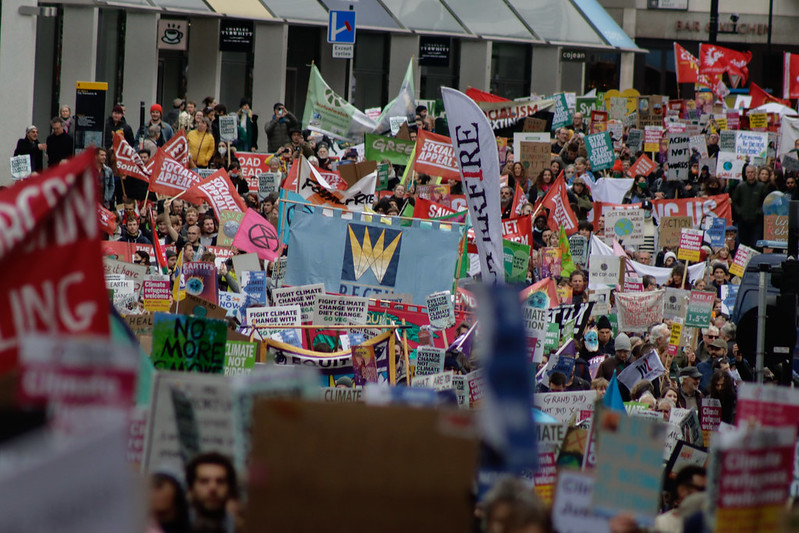 If you want a hopeful outlook for the future, then you should look at the hundreds of millions of workers and young people who have risen up to fight for a better world / Image: Steve Eason, Flickr
If you want a hopeful outlook for the future, then you should look at the hundreds of millions of workers and young people who have risen up to fight for a better world / Image: Steve Eason, Flickr
Others, like The Economist, point to the huge amount of investment that is needed and argue that: “Pledges alone do not alter the fact that firms have little reason to invest trillions in green technologies that still have mediocre risk-adjusted returns.”
It can be easy, seeing all of this, to throw your hands up in despair. If, after 26 COPs, nothing has changed, what will the 27th, 28th or 29th achieve? However, the despair of these bourgeois publications reflects the limits of the system they defend. It is not humanity that is incapable of dealing with the climate crisis, but capitalism.
There is plenty of money available to develop green infrastructure. Technologies exist that could carry out a rapid transition away from the use of fossil fuels without costing a single lost job or any loss of pay. The problem is that the world’s resources and technology are largely in the hands of big business and wealthy individuals whose only concern is profit. But there is not much profit to be made in saving the planet. Only a democratically planned economy, where real power is in the hands of the working class, is capable of dealing with the climate crisis.
The reason why our so-called world leaders look ridiculous is because they are trying to square a circle. The task of dealing with climate change within the capitalist system is impossible because it is the capitalist system itself that is responsible for the mess in the first place.
If, therefore, you want a hopeful outlook for the future, then you should look away from the pointless pantomime of COP26 and instead look at the hundreds of millions of workers and young people who, time and again in the very recent period, have risen up to fight for a better world.

